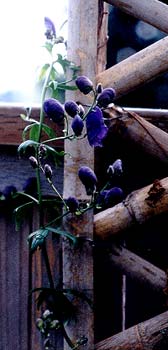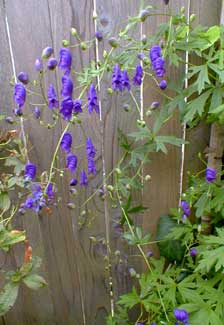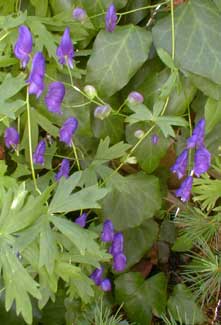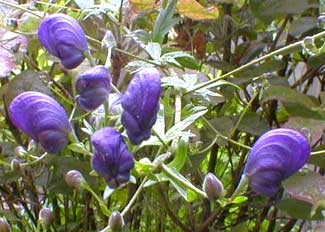
'Sparks' Monkshood
"Oftentimes you may see the signor doctor at work, & perchance the signora, his daughter, too, gathering the strange flowers that grow in the garden."
"Rappaccini's Daughter" by Nathaniel Hawthorne
(1804-1864)
(1804-1864)
'Sparks' (aka 'Spark' or 'Spark's Variety') is an amethyst-blue hybrid of Autumn Monkshood (Aconitum henryi) crossed with Bicolor Monkshood (A. cammarum). If trellised or staked, it is one of the tallest & lankiest monkshoods, but if left to its own devices, it is semi-vining, either climbing through a nearby bush, or if lacking such support, collapsing into a clumpy "pile" out of which loose sprays of long-lasting hood-flowers arise.
 It's the only monkshood we have that would require staking to remain upright. As it is planted near enough a fence in front of the Algerian Ivy trellis, I have each year the option of binding it to the trellis, which I did for 2002 when it sprang up to more than six feet tall & peeped over the high fence. But in 2003 & 2004, I let it have its way as a semi-creeping/vining perennial which winds about through the Whitethroat Azalea.
It's the only monkshood we have that would require staking to remain upright. As it is planted near enough a fence in front of the Algerian Ivy trellis, I have each year the option of binding it to the trellis, which I did for 2002 when it sprang up to more than six feet tall & peeped over the high fence. But in 2003 & 2004, I let it have its way as a semi-creeping/vining perennial which winds about through the Whitethroat Azalea.Because catalogs fail to mention that it will be tall only if staked or trellised, I wondered if ours is different from the average in being so windingly stemmed. More likely this is a feature that would sound negative if honestly described as "will not stand up on its own," so that's left out of catalog discriptions. I generally avoid the types of perennials that tip over without support, but 'Sparks' is a fine exception since it does behave like a vine instead of a tippy perennial
I did not at first know what to make of one catalog description that called Sparks "the most diminutive variety we offer," very compact & only two to three feet tall. Ours when staked grows five to seven feet tall. Perhaps the cultivar really does have strains that are that varied from one grower to the next; or perhaps that one catalog described it unstaked. All other catalogs described it as very tall & airy, quite the opposite of compact & diminutive.
 Only when we stopped staking was it after all credible to describe it as a short monkshood. 'Sparks' left unstaked coils upon itself forming a twisty fluffy clump of leaves as short as two feet, though even then the wirey stems of flowers rise to four feet. Then after it matured into a bigger clump, it looked most pleasant creeping through stems of the large deciduous azalea to release its blooms in full sunlight by the path.
Only when we stopped staking was it after all credible to describe it as a short monkshood. 'Sparks' left unstaked coils upon itself forming a twisty fluffy clump of leaves as short as two feet, though even then the wirey stems of flowers rise to four feet. Then after it matured into a bigger clump, it looked most pleasant creeping through stems of the large deciduous azalea to release its blooms in full sunlight by the path.The best distinguishing feature of 'Sparks' other than its coiling clumping or vining capacity are the loosely branching flower stalks, as opposed to the tight tall flower spikes of most varieties. The second photo, from July 2003, perfectly captures how extreme is the loose organization of blossoms.
The third photo (August 2003) shows more loose clusters of flowers amidst the semi-creeping stems of leaves clamboring amidst the Algerian ivy; & fourth photo (July 2004) shows a stem of blooms that has wound through the azalea. The flowers are in full form for seven or eight weeks, through nearly the whole of July & August, with a lingering bit of flowering still in early September. This is a longer stretch than for most of the monkshood varieties we've planted, not counting later reblooms of a few that have their first blooms earlier in the year.
Most of our monkshoods when they go to seed can still be oddly decorative, because some have seeds shaped like upside-down "bloomer girl" bloomers such as were worn by suffragists in Victorian times. Others look like wee green four-tentacled cuttlefish. Our 'Sparks' however produces no seeds. The flowers just shrivel & shrink & very slowly faded away. This failure to set seeds, however, is offset by the flowers lasting an extended period of time.
 It is fond of the sun, & one reason ours got so tall when staked in 2002 was because it wanted to peek over the fence at the morning sun (as in the first photo at top of the page). It does need some protection to prevent leaf-scorch, & will want extra watering if placed in fuller sun.
It is fond of the sun, & one reason ours got so tall when staked in 2002 was because it wanted to peek over the fence at the morning sun (as in the first photo at top of the page). It does need some protection to prevent leaf-scorch, & will want extra watering if placed in fuller sun.Occasional fertilizing with 5-10-5 will insure maximum flowering. It develops quite a big root system which does not like to be dug up & divided, but if it is to be propagated through division, once every five years is enough.
Because monkshood is very poisonous it should be handled with a degree of care, though it does make good cut flowers for bouquets.
Legend has hounded this genus since antiquity (spot the pun!), with numerous associations with witchcraft, homicide, suicide, the underworld goddess Hecate, monkshood having been said to have grown from the deadly slobber of the hell-hound Cerberus.
Called also Dogbane & Wolfbane, canine associations continue into modern times, as when Bela Legosi informs the tragic, cursed Lon Chaney, Jr., in Wolf Man (1941) that he will become a werewolf on the night of the full moon when the Wolfbane blooms. The cinematic flower legend was was encountered in an even earlier werewolf movie, Werewolf of London (1935), in which two werewolves fight over the disposition of an imported Himalayan flower that blooms only in the light of the full moon, & which has the medicinal capacity to stop the terrifying transformation. Then in the modern "girl werewolf" film Ginger Snaps (2000), dried monkshood flowers were "cooked" like heroin & injected as a cure for lycanthropy.
Although monkshood's association with werewolves is a myth that originates in Hollywood cinema, the idea has migrated to horror fiction generally, & had its ancient inspiration in monkshood's association with Hecate's dark realm & the hell-hound Cerberus.
Aconitum x napellus 'Newry Blue'